THIS WEEK
NEW YORK'S MASTER RESTAURATEURS:
An Interview with Thomas Keller
By John Mariani
NEW YORK CORNER
LINCOLN RISTORANTE
By John Mariani
THE MAGDALENE LAUNDRIES
CHAPTER EIGHTEEN
By John Mariani
NOTES FROM THE WINE CELLAR
BORDEAUX FACES PRICE DECREASES
By John Mariani
By John Mariani
Photos by Deborah Jones
.jpeg)
The Kitchen at The French Laundry
Not until he turned thirty did Thomas Keller have any name recognition in culinary circles. Born in 1955 in Oceanside, CA, and raised in Palm Beach, FL, he began cooking in restaurants as of 1974; ten years later he was doing stages in some of France’s finest restaurants, like Taillevent and Guy Savoy, then began garnering attention in 1985 at Raphael in New York as a chef’s chef known for his attention to detail. In 1990 he opened his own restaurant in New York, Rakel, where he was recognized as one of the young innovators of modern French cuisine.
Keller then moved to California where he launched an olive oil brand, EVO, but in 1994 opened his dream restaurant in Yountville, The French Laundry (below), in the wine country of Napa Valley, where his commitment to high-end fine dining with multi-course tasting menus and stellar wine list catapulted him to the top ranks of American chefs. There, he also opened a bistro named Bouchon (below, right) and casual eatery, Ad Hoc.It took ten years before he headed back to New York to open a sophisticated dining destination named Per Se, and he won every culinary award possible, including a slew of Michelin stars and The Culinary Institute of America’s “Chef of the Year.”
 Offers poured in—he was even the consultant for Pixar’s animated movie “Ratatouille”—and he wrote best-selling cookbooks (The French Laundry Cookbook sold 1.3M copies), designed cutlery and expanded his restaurant holdings and pop-ups to Las Vegas, Beverly Hills and a dozen other locations. On the 20th anniversary of Per Se’s opening, Keller threw a celebratory party that drew the best chefs and restaurateurs in New York. I interviewed Keller soon after.
Offers poured in—he was even the consultant for Pixar’s animated movie “Ratatouille”—and he wrote best-selling cookbooks (The French Laundry Cookbook sold 1.3M copies), designed cutlery and expanded his restaurant holdings and pop-ups to Las Vegas, Beverly Hills and a dozen other locations. On the 20th anniversary of Per Se’s opening, Keller threw a celebratory party that drew the best chefs and restaurateurs in New York. I interviewed Keller soon after.
Before Rakel, where did you work?
Before Rakel I was the chef de cuisine at Restaurant Raphael in New York City.
What were you trying to do at Rakel in terms of direction?
Some called us innovative then, and some described our food as modern American-French fare. We wanted to celebrate classical French cuisine and the fundamentals, but in an approachable way. We had an à la minuit style where we encouraged the team to iterate at the moment and respond to the ingredients, the guests, and the moment. This perspective extended to our family meals, when everyone had a say in our menu and wine program.
Why did you relocate to Los Angeles after Rakel?
It felt like the right thing to do then—to explore the west coast.
.jpeg)
Why did you stop cooking to make olive oil?
I wasn’t just making olive oil; I was cooking private dinners around Los Angeles. Both were a means to an end. By then, I was pursuing The French Laundry. I couldn’t take another job as a chef and try to buy the restaurant. I needed to focus on the goal of buying The French Laundry and not be distracted. So, the olive oil and private dinners were a means of paying rent.
You told me you used to work at The French Laundry so many hours that you’d fall asleep on the kitchen table. When did that stop and how were you able to open Bouchon and Ad Hoc?
How did I wake up?
Bouchon opened four years later and by then we
had a new kitchen and a bigger team. Things
were much different by then.
%20.jpg) Had you always
wanted to return to New York once you
settled in California?
Had you always
wanted to return to New York once you
settled in California?
No. I wasn’t
thinking about it at all. But when the
opportunity arose at Columbus Circle, it was
an inspiring moment for me. I knew then that I
would return but had never planned on
it.
Twenty years
ago did you envision the kinds of
international recognition you’ve received?
Of course not! When
one of our restaurants receives recognition,
we celebrate, but I remind them that it’s
really not about awards, for they are given to
you for what you did yesterday. We are a
restaurant group always looking to
tomorrow—where our greatest challenges and
gratifying successes lie. There are so many
more stories of success and failure, but the
one thing that remains with all of us here at
the end of the day is the desire and
commitment to return to work tomorrow with the
one goal of doing a little better than the day
before. That one goal continues to drive us to
new heights and accomplishments. 
When and why
did you branch out to other cities?
Since your cuisine is so personalized, are you concerned about how it is being done when you cannot be in all 11 of your restaurants and bakeries?
Our staff has been trained to treat one guest at a time. While I cannot be everywhere at once, I trust that my staff runs the kitchen with the same urgency and collaboration I once did. Ultimately, a great meal is about something other than the food and wine. A great meal is an emotional experience. We make it an extraordinary one by establishing a beautiful place filled with a staff that cares about it as they do about their home, where we treat one guest at a time. With this approach, we care for you, and you become the central focus of your experience. Our chefs are meticulous about culinary details, fundamental techniques, and a kitchen that delivers the best products of the earth to the table. No detail or element can be less important or more important than another. A great meal does not necessarily fill you up. A great meal is a journey that returns you to sources of pleasure you may have forgotten and takes you to places you haven't been before.
Lincoln Center
142 West 65th Street
212-359-6500
By John Mariani
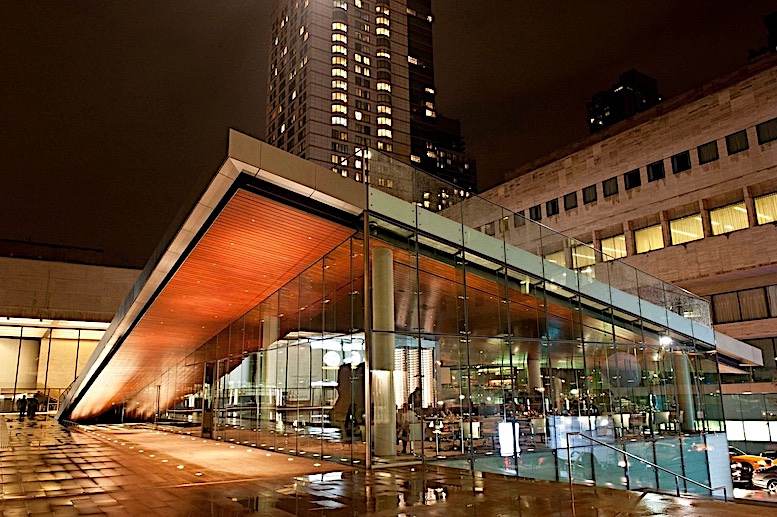
The
opening
of Lincoln Ristorante in 2010 was a signal
moment for both Lincoln Center and the Upper
West Side, which had nothing like an upscale
Italian restaurant
at that time and certainly no dining edifice
within an all glass trapezoidal shape.
Designed by Diller, Scofido + Renfro, Lincoln
was unique in every way, set on the north side
of Lincoln Center Plaza in view of the Henry
Moore statue set in a shallow reflecting pool
and across from the Vivian Beaumont Theater
and Juilliard.  The roof,
topped with a grass lawn that functions as a
small public park, is slanted and inside the
ceiling provides for both a very open and airy
dining section with another to the rear and a
section of booths across from the gleaming,
well-lighted glassed-in kitchen and Negroni Bar and
Prosecco Bar, which stocks 350 wines on the
list, many from small producers, overseen by
the affable bartender Mario Jurkovsky.
The roof,
topped with a grass lawn that functions as a
small public park, is slanted and inside the
ceiling provides for both a very open and airy
dining section with another to the rear and a
section of booths across from the gleaming,
well-lighted glassed-in kitchen and Negroni Bar and
Prosecco Bar, which stocks 350 wines on the
list, many from small producers, overseen by
the affable bartender Mario Jurkovsky.
Executive Chef Artem Orlovskyy has a
long tenure at Lincoln and has continued to
create concise, well-crafted menus based on
Italian culinary traditions with creative
flourishes and depths of flavor, as does
Executive Pastry Chef Kara Blitz with her
beautiful desserts.
Among the antipasti is a big, knobby
pull-apart focaccia ($16) filled with 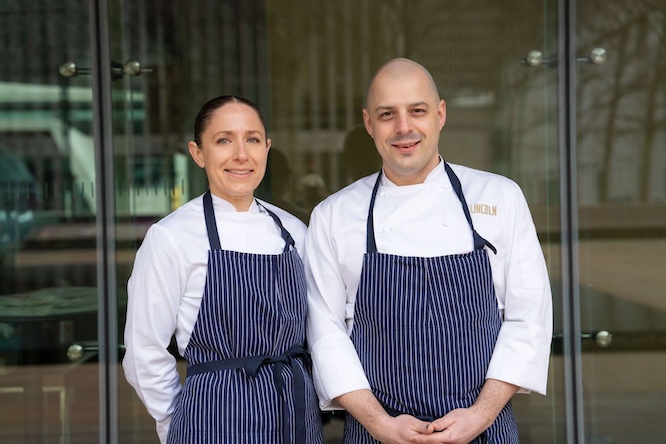 potato and
sweet onions, with a broccoli di rabe pesto. A
basil pesto accompanies crispy arancini
balls studded with spring peas and oozing scamorza
cheese ($18), while a platter of moist polpette
meatballs made with prosciutto and
mortadella are napped in tomato sauce and
dusted with pecorino ($16). Eggplant
parmigiano ($25) is a lush and generous tart
made with caramelized onions, San Marzano
tomatoes and a rich parmigiano fonduta
($25). All dishes get an extra flourish.
potato and
sweet onions, with a broccoli di rabe pesto. A
basil pesto accompanies crispy arancini
balls studded with spring peas and oozing scamorza
cheese ($18), while a platter of moist polpette
meatballs made with prosciutto and
mortadella are napped in tomato sauce and
dusted with pecorino ($16). Eggplant
parmigiano ($25) is a lush and generous tart
made with caramelized onions, San Marzano
tomatoes and a rich parmigiano fonduta
($25). All dishes get an extra flourish.
Orlovskyy could have padded his menu
with the usual pastas people expect, but
instead he focuses on six very sumptuous types
you rarely see, including the ribbed Sardinian
saffron gnocchi called malloredus
($36),
lavished
with garlicky lamb sausage and tomato ragù and
pecorino. The small orzo pasta shapes are
treated to lump crabmeat, buttery leeks, a
crab cream and garlic chips ($40), while a
hearty spaghettoni
($27) incorporates springtime’s ramps into
a pesto
with pine nuts and pecorino sardo
(left).
These are healthy portions and may be shared
as a pasta or enjoyed as a main course.
 Of the main courses there
are but four. The duck sausage with gnocchi,
morel mushrooms and English peas ($48) is both
unusual and very filling, while the monkfish
in a saffron broth with mussels fingerling
potatoes and grilled croutons ($48) was a bit
complicated. A simply grilled branzino ($52)
with a “burnt” eggplant cream and vegetable
salsa was more satisfying for its essential
flavors. On the side patate
fritte ($17) come with a delightful
scallion aïoli.
Of the main courses there
are but four. The duck sausage with gnocchi,
morel mushrooms and English peas ($48) is both
unusual and very filling, while the monkfish
in a saffron broth with mussels fingerling
potatoes and grilled croutons ($48) was a bit
complicated. A simply grilled branzino ($52)
with a “burnt” eggplant cream and vegetable
salsa was more satisfying for its essential
flavors. On the side patate
fritte ($17) come with a delightful
scallion aïoli.
Blitz
delivers five desserts, each as good as the
next, which includes a gelato
al cioccolato ($18)  with
Nutella-like hazelnut praline swirl, poached
cherries and chocolate crumble to add texture,
while a millefoglie
using crisp cannoli dough on top of vanilla diplomate
and a poached rhum coulis is a triumph of
flavors ($19). Piccolo forno (little oven) is
constructed of truffles, dark, milk and white
chocolate, mini cannoli, pâté de
fruit ($25), and the addition of a farro
grain crust,
wildflower honey and fiore di
latte to a rich lemon custard
($19) is an enchantment of simple tastes.
with
Nutella-like hazelnut praline swirl, poached
cherries and chocolate crumble to add texture,
while a millefoglie
using crisp cannoli dough on top of vanilla diplomate
and a poached rhum coulis is a triumph of
flavors ($19). Piccolo forno (little oven) is
constructed of truffles, dark, milk and white
chocolate, mini cannoli, pâté de
fruit ($25), and the addition of a farro
grain crust,
wildflower honey and fiore di
latte to a rich lemon custard
($19) is an enchantment of simple tastes.
The service staff has always been of
high caliber and cordiality at Lincoln, and
when we were seated at a very comfortable but
dark booth, the hostess whipped a table lamp
over to provide just the right, soft lighting
we needed.
New
York now has a good number of highly refined
but very comfortable Italian ristoranti
like Il Gattopardo, Casa Lever and Fasano
(in addition to scores of trattorias) that
rank with the best in Rome, Milan and
Florence. But none anywhere has the dazzling
décor and ambience of Lincoln along with such
exquisite cuisine.
Open
Tues.-Sat. for dinner.
THE MAGDALENE LAUNDRIES
By John Mariani
 Neither Katie nor David had ever been
to Ireland, so in the little time they had
before boarding an Aer Lingus flight to Dublin,
they boned up on the city and got their contact
sheets in order. David would see if the sources
provided by his Irish cop friends would open any
doors, while Katie would call on Church
officials and try to locate some of the girls
who had emerged from—Katie felt “survived”—the
Magdalene Laundries.
Neither Katie nor David had ever been
to Ireland, so in the little time they had
before boarding an Aer Lingus flight to Dublin,
they boned up on the city and got their contact
sheets in order. David would see if the sources
provided by his Irish cop friends would open any
doors, while Katie would call on Church
officials and try to locate some of the girls
who had emerged from—Katie felt “survived”—the
Magdalene Laundries.
They hoped there would be some time to see
the capital city of Ireland, which over the past
five years had taken on the moniker of Celtic
Tiger with reference to the tremendous economic
strides made after decades of poverty and
unemployment, with a subsequent rise in tourism.
New hotels were being built and old ones
refurbished, the parks and museums were being
restored and new restaurants were opening all
around the city, oddly enough with most serving
French menus.
Their flight from JFK landed at Dublin
Airport on a Saturday morning, when Dubliners
would be off and the city engorged with American
and European tourists. Not a good time to be
knocking on police headquarters’ or old-timers’
doors.
Battling jet lag, the two Americans took
rooms at the historic Shelbourne Hotel (below)
on St. Stephen’s Green. Dating back to 1824, it
was always the most posh in town: the Shelbourne
had gaslight by 1867, electricity by 1881 and an
elevator by 1900.
During the Easter Rebellion of 1916 the
building had been commandeered by forty British
troops, with sharpshooters arrayed on the fourth
floor to fire on the Citizen Army, whose members
in turn left bullet holes in the building’s
façade. Six years later the hotel was where
Michael Collins signed the new Constitution, in
Room 112.
All of this was of great interest to Katie,
who’d gotten a good dose of Anglo-Irish history at
Fordham, so she hoped she’d have time to visit
some of the other seminal locations in the city
where the Rebellion took place. David was more
interested in walking around the city to
familiarize himself with its lay-out and
neighborhoods. If he was looking for a killer, he
needed to know the geography. He also
wanted to compare the pubs in Dublin with those he
knew back in New York.
After breakfast in the hotel’s lounge,
Katie and David went to their respective rooms for
an hours’ nap to shake off the jet lag. When
David arrived back downstairs in the lobby, he
remarked that Katie looked as fresh as a daisy and
that he felt like crap.
“A good stretch o’ the legs in the Oy-rish
air will do ya good, Davy,” she said in a bad
brogue, taking him by the arm and heading out
under a gray autumn sky with more than a hint of
rain in it. They walked through the park, where a
statue of a bemused native son, Oscar Wilde,
reclined, then around the streets that led to the
Ha’Penny Bridge over the Liffey River. Along
the way they walked through Temple Bar, which was
quickly catching on as a center for galleries,
boutiques and cafés, stopped for coffee and kept
walking through lunchtime, crossing the river and
finding a wistful statue of James Joyce leaning on
his cane on the other side.
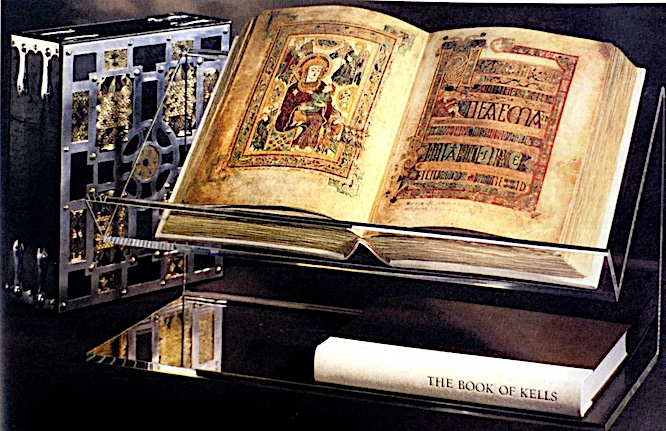 With
not
enough time to visit any of the city’s museums,
they headed down Grafton Street to Trinity
College, where they were able to see displayed the
ancient Book of Kells. Then it was along Nassau
Street, where Katie noted a unique Donegal tweeds
shop named Kevin Howlin that she made a mental
note to visit if they had the time.
With
not
enough time to visit any of the city’s museums,
they headed down Grafton Street to Trinity
College, where they were able to see displayed the
ancient Book of Kells. Then it was along Nassau
Street, where Katie noted a unique Donegal tweeds
shop named Kevin Howlin that she made a mental
note to visit if they had the time.
That night the couple dined at a
traditional Irish restaurant named Roly’s Bistro
out by the rugby stadium, enjoying a platter of
Dublin Bay prawns, a loin of a venison with
Colcannon potatoes and a bottle of wine, then
winding down the evening at a pub for the
requisite pint of Guinness and Irish folk music.
David remarked that the Guinness tasted
much richer than in the States, though he felt as
at home as an Italian-American ex-cop could in a
pub crowded with locals and tourists listening to
old Irish rebel ballads like “The Rising of the
Moon,” which he’d heard a thousand times back in
New York.
The next day was Sunday, and, as usual,
David was happy to join Katie at Mass, this time
at the grand  Saint
Patrick’s Cathedral, whose dean was once Jonathan
Swift.
Saint
Patrick’s Cathedral, whose dean was once Jonathan
Swift.
“Doesn’t look much like Saint Patrick’s in
New York,” said David.
“Well, it’s more or less Gothic
architecture, like New York’s,” said Katie, “but
it says here it goes back to the twelfth century
and has seen a lot of decay and changes. Very
beautiful though, isn’t it?”
David nodded, content to be sitting in the
old pews with Katie, her head covered with a blue
beret, the smell of incense billowing into the
nave.
After lunch, they returned to their hotel
to plan their investigations. David said he’d put
in calls to the contacts he’d been given,
including Max Finger, and arrange to meet them as
soon as possible.
Katie had an address on Seán MacDermott
Street—named after Seán Mac Diarmada, a hero of
the 1916 Rising—where the Magdalene Laundries
building still stood, as well as the name of the
graveyard where the bodies of women and children
had allegedly been buried.
When Katie and David got to the street
north of the Liffey where the Laundries was
located, they found little but new public housing
and private developments, all of them wholly
without character. But there was still one old
building among the rest, one large enough to
extend a block over to Montgomery Street. The
building was built of gray-brown brick, now grimy
with soot, with windows edged in red and a rusted
black railing gate topped with crosses, some
snapped off; above the peeling wooden entrance
door was a sooty carving of the Madonna and Child. A “For
Sale” sign hung on a pole on the sidewalk. It was
as grim a place as Katie could imagine for young
girls and women trapped inside and barely able to
look out onto the lives passing by on the streets
of Dublin. Beside the building was another,
smaller one, which Katie took to be the convent
where the Sisters of Charity lived and prayed.
 “It looks like a prison,” said Katie.
“It looks like a prison,” said Katie.
“More like a madhouse,” said David, who
knew the differences well. “No bars
on the windows.”
Katie hailed a taxi and asked the cabbie to
take them to the Drumcundra cemetery. “Catholic or
Jewish?” he answered. “They’re two of them over
there, Miss.”
“Catholic, please.”
“That would be St. John the Baptist,” he
said, “Fifteen minutes drive. Okay?”
“Drive on,” said Katie.
The ride took them out of the center of
Dublin, farther north through streets still
impoverished, lined with shabby row houses, some
looking similar to the Magdalene Laundries
building, sadder still under the gray Irish cloud
cover.
“You’re Yanks?” asked the driver.
“Yeah, from New York,” replied David.
“My daughter lives in New York. Astoria,
Queens. I visit her every year. And why, may I
ask, would you be wantin’ to visit the Drumcundra
cemetery? It’s
not on the usual tourist routes.”
Before Katie could answer, the cabbie said,
“Must be to see the graves of those poor girls
from the Laundries.”
Katie was taken aback by the suggestion and
said, “As a matter of fact, I am. I’m a journalist
and I’m looking into what happened to those women
and how they were brought out here to be buried.”
“You won’t find anythin’, if you don’t mind
my sayin’ so. Most Irish just want to forget it
all happened a long time ago. Past history. Let it
go.”
“But what about the parents and friends of
all those women?”
“I’m sorry to say this, Miss, but the Irish
have a long memory and they
keep it to themselves. What’s done is  done.
No use stirrin’ up graves over it.”
done.
No use stirrin’ up graves over it.”
Katie took the man’s assertion seriously.
The very fact that there had been so little
reported about the Laundries and the scandal of
the Drumcundra graves in the Irish press led her
to believe that she would have a difficult time
finding people to talk about all of it. She was
wholly determined to find out what she could about
the gravesite, but she fully realized that Alan
Dobell wanted a murder mystery story, and he
trusted Katie and David to deliver it.
At first sight, Katie and David found
Drumcondra as postcard pretty as they could
imagine a country churchyard could be. Silent,
with a small stone cottage-like church whose sides
were covered with ivy, with a plaque noting that
Drumcondra dated back to 1743. There
was a list of local names of prominent men, none
of them familiar to Katie and David. The old
graveyard headstones, many leaning in the sod,
came up almost to the church walls. Tall ancient
elm, yew and pine trees surrounded the graveyard,
and the lawns were the only things that looked
attended to.
Katie and David heard a voice call to them
from behind.
“I trust you’re here to see the Magdalene
children’s graves.”
© John Mariani, 2018
❖❖❖
BORDEAUX’S VINTNERS WORRY
ABOUT DECREASE
IN PRICE
PERFORMANCE FOR 2023 VINTAGE
By John Mariani
Global
turmoil in the world’s wine industry hasn’t
caused major wine regions to curtail
production—at least not yet. But in Bordeaux
there are fears of a cut-back in consumption
at a time when there is a global glut of wine.
I spoke with Tara Albini (below), head
of clients and marketing for Wine Lister,
consults who offer strategic recommendations
for producers, regional associations and
merchants, as to why there is now high anxiety
in the industry about en primeur
sales, which are first prices set for the new
vintage in the trade before release to the
public.

Bordeaux, like Burgundy and most
wine regions, has shown a decrease in price
performance: 8% in 2023. What are the principal
reasons for this slow-down?
Over the past four years,
socio-economic instability has cut the spending
power of many of the buyers that once drove demand
for the world’s premium fine wines, with the
market taking a notable hit in 2023. With global
economic turmoil incited by two major
wars, ever-rising inflation, and ongoing
recuperation from the pandemic, consumers around
the world have been forced to tighten their purse
strings.
Coinciding with this
phenomenon, release prices of Bordeaux’s top wines
have increased to unprecedented heights, with the
2022 en
primeur campaign seeing an average increase
of 20%. As a result, the latest vintage entered
the market at a similar, if not higher, price than
back vintages that are currently in their drinking
window, hindering immediate demand for, and
interest in, Bordeaux’s historical en primeur
system. With excess stock on the market, and a
growing belief that a wine will be available to
purchase in bottle at the same or a lower price
further down the line, en primeur investments,
and consequential price appreciation, has slowed
down.
Why does Bordeaux suffer from
“market fragility?”
Bordeaux’s production volumes are
higher than in Burgundy or California, and there
is a reported surplus of its wine available on the
market due to demand slowing down. This means that
consumers will be less sympathetic to major price
increases and feel less urgency to acquire its
wine during periods of economic instability. One
specialist U.S. merchant tells us, “Many of my
buyers, who are collectors in other regions, don't
collect young Bordeaux because they know they can
get wines entering or firmly in their drinking
plateau from standard distribution.” 
In addition to this, the low
trade margins made by merchants similarly
disincentivize them to focus on Bordeaux en primeur,
particularly when there is an imbalance between
pricing and demand. One U.K. merchant notes, “The
fact most U.K. merchants can only make 10% margin,
what is the point of investing in a campaign with
such low margins, when all other merchants also
sell the same wine to the same customers?”
You report there is “anxiety” over
the higher production in the 2023 harvest. What
impact will that have on prices?
Higher production volumes as an
isolated phenomenon would not cause anxieties,
yet, in the context of the current Bordeaux
market, it has added to existing worries
surrounding the surplus of stock on the market.
Several trade members cited the lower quantities
of recent vintages, such as the 2022, as a factor
for inciting demand in the future, despite their
augmented prices. With volumes back to normal, or
in some cases above average, scarcity cannot be
used as a selling point for the 2023, meaning that
prices will need to be more attractive in order to
encourage demand.
Yet your report says that
Bordeaux’s “popularity” is up 8%. How does that
coincide with the decrease in prices?
Wine Lister’s regional popularity
ranking is a relative measure based
on Wine-Searcher search data on the top
20 wines by Wine Lister pro score in each region
(Bordeaux, Burgundy, California, Champagne,
Piedmont, Spain, and Tuscany). Each region has
seen average searches decrease for the top 20 fine
wines examined over the past two years, but
Bordeaux's popularity has fared better than
Burgundy, California, Champagne, Spain, and
Tuscany, hence its relative position being up 8%.
This is likely a result of Bordeaux’s strongest
fine wine brands being so established over
centuries, and being less subject to passing
trends.
What are the top five “pro score
improvers” in quality?
Wine Lister’s Quality score comprises
an aggregation of our partner critics’ tasting
scores (Jancis Robinson; Vinous (Antonio
Galloni and Neal Martin); Jeannie Cho Lee; Bettane+Desseauve;
Jasper Morris; and Le Figaro Vin) and a
modest weighting for aging potential (the average
length of our partner critics' suggested drinking
windows). Berliquet sees the greatest increase in
Quality score over the past year (16%), followed
closely by d'Angludet, which misses the top spot
by decimals. Durfort-Vivens and Dassault appear in
third and fourth place with 15% and 14%,
respectively, while Fonroque takes the fifth spot
with a 12% increase.
What programs or efforts are being
made to improve demand for the 2023 en primeur campaign?
Bordeaux châteaux are putting more
effort than ever in marketing their wines and
communicating with trade members and consumers.
Having worked with over 100 of the world’s leading
fine wine producers on various strategic
consulting and marketing activities, Wine Lister’s
communication division has seen increased interest
from the region’s top producers over the last two
years. We have worked with 18 Bordeaux estates on
various types of PR collaborations, event
organization, and marketing strategy advice. These
estates recognize that, in an increasingly
competitive fine wine market, it is not the time
to rest on your laurels, and are instead making
significant effort to connect with those that
drive demand.
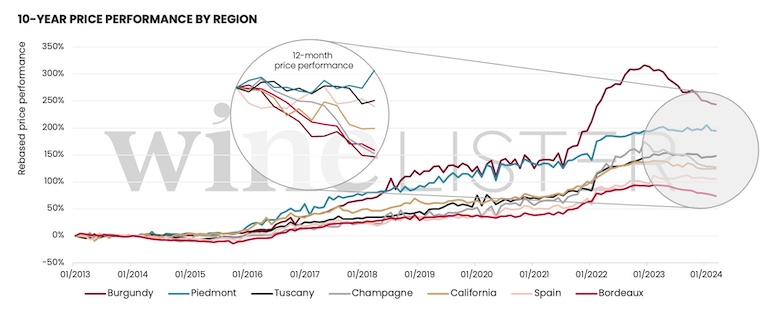 Meanwhile, many of the region’s top
châteaux have made significant investments in
their oeno-tourism facilities (for example,
Pauillac’s Grand-Puy Ducasse will be opening its
doors to visitors for the first time in 2024,
thanks to the launch of its new tourist trail), to
encourage visits from trade, press, and
consumers.
Meanwhile, many of the region’s top
châteaux have made significant investments in
their oeno-tourism facilities (for example,
Pauillac’s Grand-Puy Ducasse will be opening its
doors to visitors for the first time in 2024,
thanks to the launch of its new tourist trail), to
encourage visits from trade, press, and
consumers.
You surveyed 57 people in the
global wine trade as to whether a decrease in
average market price vs compromised sales of
existing stocks of recent back vintages would
help sales, and the great majority (91% ) of the
Americans polled said there would be no impact.
Why would lower prices not affect the market?
There is consensus that demand for
recent back vintages is compromised as a result of
ever-increasing prices, with a feeling of
disillusionment towards the en primeur
system taking its toll on the region’s wines as a
whole. Ten of the leading trade members surveyed
explain that a pricing reset is needed to
reinvigorate interest in both the en primeur
system and existing stock of recent releases. One
major Bordeaux négociant
explains that “if the deal is good, and the trade
can make a profit, demand will arise [and would]
create goodwill. […] Prices will naturally rise
again, making the old vintages attractive once
more.” Additionally, nine respondents cite the
quality and limited volumes of recent vintages as
factors that would spur demand despite their
pricing being relatively higher. Seven trade
members explain that en primeur
pricing strategies do not affect in-bottle sales,
due to a separation in the consumer groups for
these two streams, and general expectations for
higher in-bottle prices, with one top tier U.K.
merchant noting, “You expect to
pay a premium for wine in bottle.”

Several U.S. respondents
mention that demand among their consumers is
influenced by the perception of the vintage (with
recent vintages being widely praised for their
quality), while others reiterate a separation
between the en
primeur and in-bottle buying streams. One
specialist U.S. merchant tells us, “Each vintage
and price will be judged on its merits—people need
wine in bottle,” while a
top-tier U.S. merchant tells us that it “Depends
on vintage perception of prior stock.”
Are the prices of the First and
Second Growths going higher? Has demand slipped
with those rated as crus?
There is no obvious trend among First
and Second Growths when it comes to post-en primeur
release price appreciation. When looking at the
relative percentage change between release prices
and current market prices by wine (vintages
2018-2022), Lafleur sees the greatest appreciation
(103%), followed by Les Carmes Haut-Brion (42%). (Petrus
and Le Pin were not included in this analysis as
they don’t release via the Place de Bordeaux
system). Carruades de Lafite comes in third place
(37%), with its demand no doubt catalyzed by its
association with its Premier Cru sibling; Lafite
Rothschild, which conversely appears in 22nd place
on the list. Similarly, Margaux’s Pavillon Blanc
appears in fifth place (29%), while the First
Growth Château Margaux appears in 21st
place.
While the wider subset of
Bordeaux wines that will see post-release price
appreciation will no doubt be predominated by Grand Cru
Classé wines, there is no evidence to
suggest that classification drives the highest
demand. It is instead a reputation for quality and
trade favorability that will increase interest in
a wine—whether it is classified or not.
 Do you expect heavy
discounting this year on Bordeaux?
Do you expect heavy
discounting this year on Bordeaux?
This is something that has been
unanimously called for by leading trade members in
all corners of the international fine wine sphere,
as revealed in our recent survey of 57 merchants,
négociants,
auction houses, and retailers from around the
world (featured in Part I of Wine Lister’s 2024
Bordeaux Study). They believe that only a
significant pricing reset can renew consumer
confidence in buying en primeur
and invigorate interest in Bordeaux as a whole.
When asked the question of what they believe to be
the maximum viable release price for the 2023
vintage versus 2022, our respondents suggest an
average discount of 30% (with some suggesting as
much as 50% discount would be appropriate), though
the response from the Americas was less extreme,
with a 20% discount called for on average.
We have just returned from 10 days tasting in
Bordeaux, and nearly every château we spoke to
confirmed they would reduce their price vs 2022.
The news on the grapevine is that these decreases
will be significant for certain top estates, who
are also planning to release very early on,
beginning on 29 April. Only time will tell whether
these discounts will be substantial enough to
answer the prayers of the international fine wine
trade.
What was the 2023 vintage like?
The 2023 vintage
required a watchful eye and sharp reactivity from
winemakers across both banks of the Gironde. The
growing season was marred by climatic challenges:
with a wet and warm spring, mildew put many
vineyards at risk, relying on the expertise and
rigor of vineyard teams to ensure healthy vines.
Fortunately, two heatwaves in the second half of
August and early September encouraged excellent
ripening and yielded high-quality harvests across
the region. Once again, careful and patient
planning was imperative to picking grapes at their
optimal ripeness. The resulting wines show great
freshness, depth and complexity—a profile that
several of Wine Lister’s producer partners have
described as “classically Bordeaux.”
❖❖❖
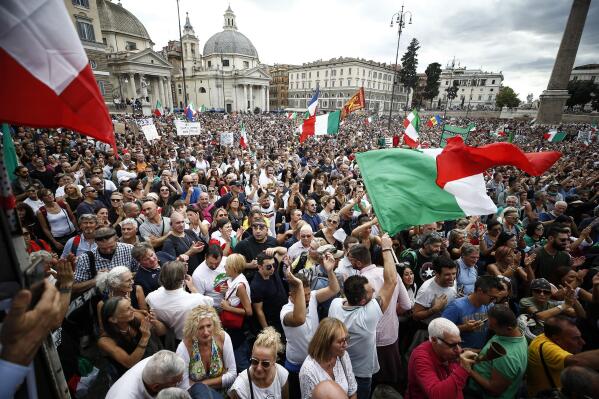 GELATO PROVEN TO CAUSE
HAVOC ON THE STREETS!
GELATO PROVEN TO CAUSE
HAVOC ON THE STREETS!
"Milan is
poised to ban sales of ice creams after midnight in
ongoing efforts to clamp down on nighttime revelers
sowing havoc on the streets of Italy’s financial
capital. The new rules devised by the city council
will ban the sale of takeaway drinks and food,
including pizza and ice cream, in 12 of Milan’s
liveliest districts."—Food & Wine.
❖❖❖
Any of John Mariani's books below may be ordered from amazon.com.
 The Hound in Heaven
(21st Century Lion Books) is a novella, and
for anyone who loves dogs, Christmas, romance,
inspiration, even the supernatural, I hope you'll find
this to be a treasured favorite. The story
concerns how, after a New England teacher, his wife and
their two daughters adopt a stray puppy found in their
barn in northern Maine, their lives seem full of promise.
But when tragedy strikes, their wonderful dog Lazarus and
the spirit of Christmas are the only things that may bring
his master back from the edge of despair.
The Hound in Heaven
(21st Century Lion Books) is a novella, and
for anyone who loves dogs, Christmas, romance,
inspiration, even the supernatural, I hope you'll find
this to be a treasured favorite. The story
concerns how, after a New England teacher, his wife and
their two daughters adopt a stray puppy found in their
barn in northern Maine, their lives seem full of promise.
But when tragedy strikes, their wonderful dog Lazarus and
the spirit of Christmas are the only things that may bring
his master back from the edge of despair. WATCH THE VIDEO!
“What a huge surprise turn this story took! I was completely stunned! I truly enjoyed this book and its message.” – Actress Ali MacGraw
“He had me at Page One. The amount of heart, human insight, soul searching, and deft literary strength that John Mariani pours into this airtight novella is vertigo-inducing. Perhaps ‘wow’ would be the best comment.” – James Dalessandro, author of Bohemian Heart and 1906.
“John Mariani’s Hound in Heaven starts with a well-painted portrayal of an American family, along with the requisite dog. A surprise event flips the action of the novel and captures us for a voyage leading to a hopeful and heart-warming message. A page turning, one sitting read, it’s the perfect antidote for the winter and promotion of holiday celebration.” – Ann Pearlman, author of The Christmas Cookie Club and A Gift for my Sister.
“John Mariani’s concise, achingly beautiful novella pulls a literary rabbit out of a hat – a mash-up of the cosmic and the intimate, the tragic and the heart-warming – a Christmas tale for all ages, and all faiths. Read it to your children, read it to yourself… but read it. Early and often. Highly recommended.” – Jay Bonansinga, New York Times bestselling author of Pinkerton’s War, The Sinking of The Eastland, and The Walking Dead: The Road To Woodbury.
“Amazing things happen when you open your heart to an animal. The Hound in Heaven delivers a powerful story of healing that is forged in the spiritual relationship between a man and his best friend. The book brings a message of hope that can enrich our images of family, love, and loss.” – Dr. Barbara Royal, author of The Royal Treatment.
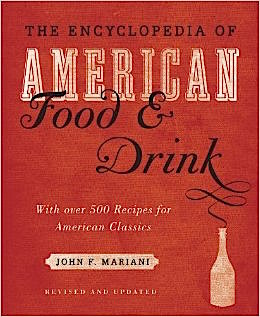 |
The Encyclopedia of American Food and Drink by John F. Mariani (Bloomsbury USA, $35) Modesty forbids me to praise my own new book, but let me proudly say that it is an extensive revision of the 4th edition that appeared more than a decade ago, before locavores, molecular cuisine, modernist cuisine, the Food Network and so much more, now included. Word origins have been completely updated, as have per capita consumption and production stats. Most important, for the first time since publication in the 1980s, the book includes more than 100 biographies of Americans who have changed the way we cook, eat and drink -- from Fannie Farmer and Julia Child to Robert Mondavi and Thomas Keller. "This book is amazing! It has entries for everything from `abalone' to `zwieback,' plus more than 500 recipes for classic American dishes and drinks."--Devra First, The Boston Globe. "Much needed in any kitchen library."--Bon Appetit. |
"Eating Italian will never be the same after reading John Mariani's entertaining and savory gastronomical history of the cuisine of Italy and how it won over appetites worldwide. . . . This book is such a tasteful narrative that it will literally make you hungry for Italian food and arouse your appetite for gastronomical history."--Don Oldenburg, USA Today. "Italian
restaurants--some good, some glitzy--far
outnumber their French rivals. Many of
these establishments are zestfully described
in How Italian Food Conquered the World, an
entertaining and fact-filled chronicle by
food-and-wine correspondent John F.
Mariani."--Aram Bakshian Jr., Wall Street
Journal.
"Equal parts
history, sociology, gastronomy, and just
plain fun, How Italian Food Conquered the
World tells the captivating and delicious
story of the (let's face it) everybody's
favorite cuisine with clarity, verve and
more than one surprise."--Colman Andrews,
editorial director of The Daily
Meal.com. "A fantastic and fascinating
read, covering everything from the influence
of Venice's spice trade to the impact of
Italian immigrants in America and the
evolution of alta cucina. This book will
serve as a terrific resource to anyone
interested in the real story of Italian
food."--Mary Ann Esposito, host of PBS-TV's
Ciao
Italia. "John Mariani has written the
definitive history of how Italians won their
way into our hearts, minds, and
stomachs. It's a story of pleasure over
pomp and taste over technique."--Danny Meyer,
owner of NYC restaurants Union Square
Cafe, The Modern, and Maialino.
|
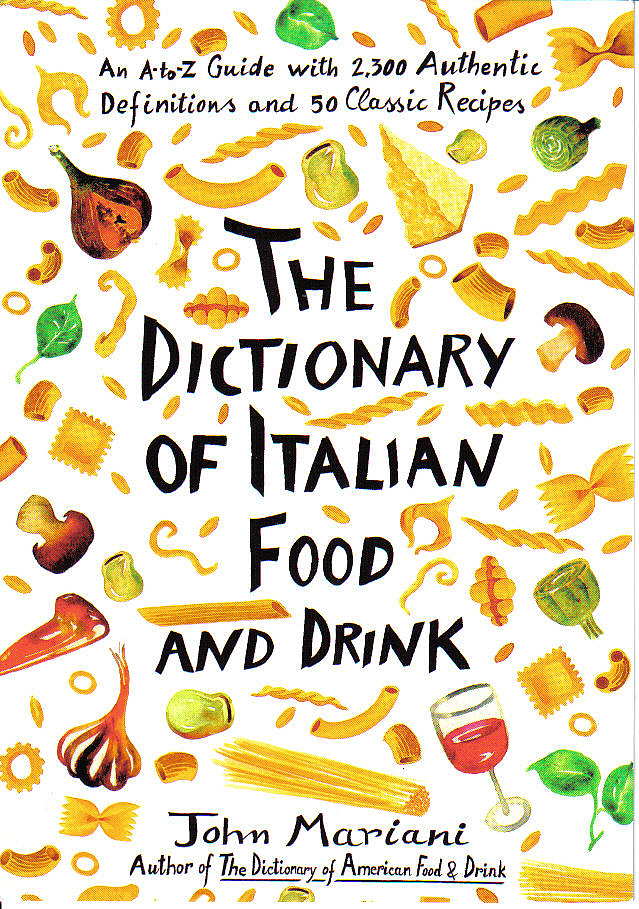 |
 |
 |
 |
 |
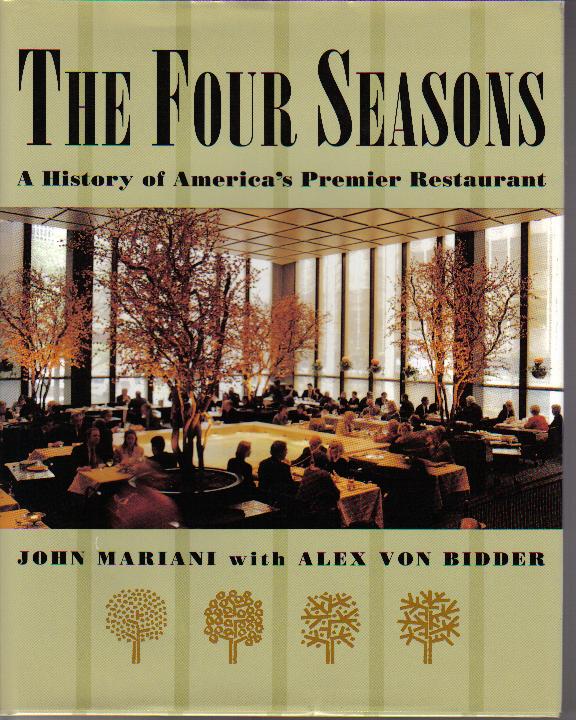 |
MARIANI'S VIRTUAL GOURMET
NEWSLETTER is published weekly. Publisher: John Mariani. Editor: Walter Bagley. Contributing Writers: Christopher
Mariani, Misha Mariani, John A. Curtas, Gerry Dawes, Geoff Kalish.
Contributing
Photographer: Galina Dargery. Technical
Advisor: Gerry
McLoughlin.
If you wish to subscribe to this
newsletter, please click here: http://www.johnmariani.com/subscribe/index.html
© copyright John Mariani 2024

